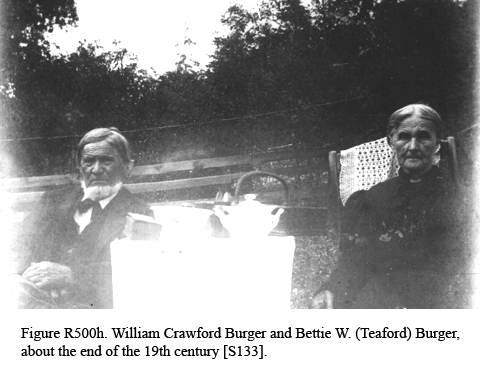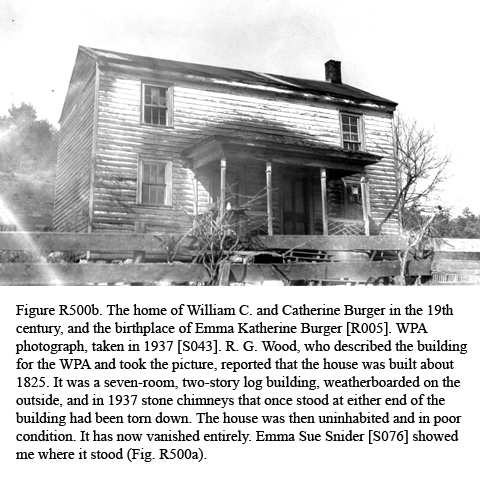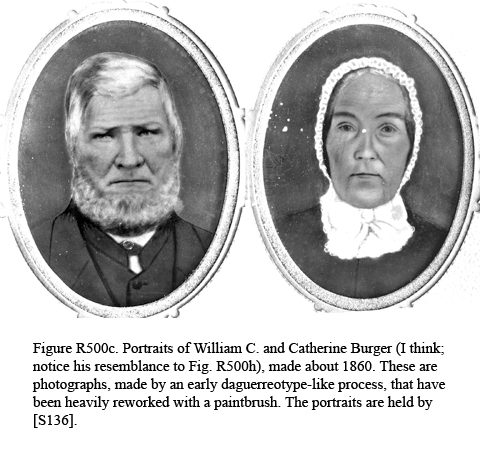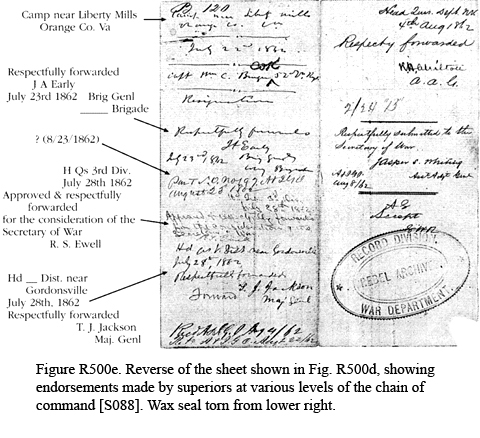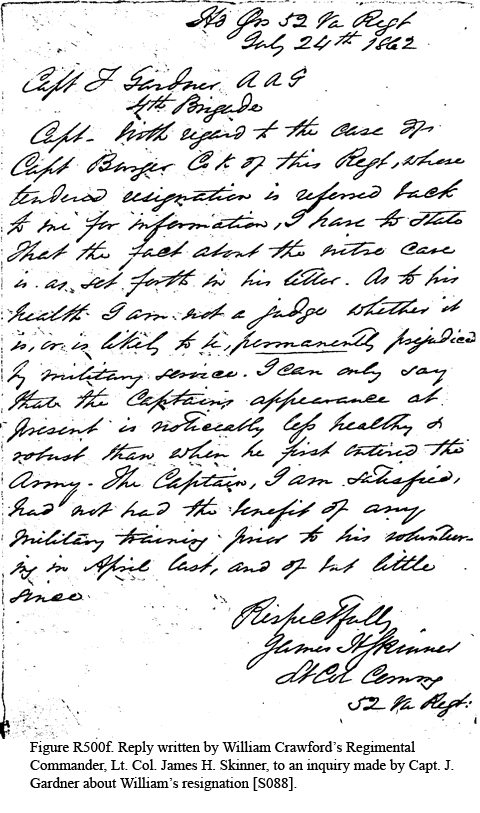R500
Husband: William Crawford Burger
Father: Joseph Burger [R505]
Mother: Martha (Crawford) Burger [R505]
Born: 3/17/1826, in Bath County
Died: 6/8/1910, buried in Burger Cemetery (see below)
First wife: Catherine Ann (Miller) Burger
Father: Morrill Miller [R501]
Mother: Jane Cauley Miller [R501]
Born: 2/25/1830 in Green Valley Va.
Died: 11/11/1863, buried in the Burger Cemetery (below)
Married: 9/3/1846 at the house of the bride’s mother, by Rev. Samuel
Brown
Children:
Mary Martha (Matt) Jane Burger, 8/21/1847-11/6/1929. M.
11/1/1866 to John Marshall Lair of Rockbridge County, who d.
7/5/1895. “Aunt Mat” (see Fig. R554d) figures prominently in the
letters [S089] of her sister, Emma Katherine Wood [R005]. Matt was
only 47 when she was widowed. She spent the rest of her life living
with one of her relatives and then another, but chiefly with Emma at
Nimrod. She seems to have had a likable personality, but after 30
years of depending upon the hospitality of others she wore out her
welcome, notably with Emma. In the end she outlived Emma, who
died in 1928.
Margaret Elizabeth (Maggie) Burger, 8/18/1849-10/8/1882, m.
9/28/1871 to George Henry Hughes (b. 9/5/1850 in Fluvanna County
Va., d. 10/18/1882), 9 children
Samuel Crawford Burger [R450], b. 7/31/1851
Alexander Stuart Burger,10/17/1853-7/11/1882, unmarried. Buried in
Burger Cemetery (below)
Charles Miller Burger [R503], b. 3/18/1856
David Franklin Burger, b. 4/29/1858, m. 11/20/1884 to Alice Victoria
Callaghan of Hot Springs Va., 7 children
Emma Katherine Burger [R005], 8/6/1860-11/10/1928
(1996) William Burger’s principal tract of land (A in Fig. R500a) and his house (Fig. R500b) were willed to him and his brother David Warner Burger [R517] in 1845 by their uncle, Samuel Crawford [R511]. William, 20, married Catherine, 16, the next year. (A preserved lock of her hair is a rich dark brown color, with a slightly reddish tint [S109]). In 1854, William bought out David Burger’s share of the property for $950 (DB11-366). In 1857 he patented tract C of Fig. R500a (SB3-120).
Like most of his contemporaries, William owned slaves. Long
after (3/5/1923), his daughter Emma wrote in a letter “Brother Sam sent
me a clipping from the Pocahantas Times telling of the death of poor old
Harry McDowel an old colored man who used to belong to my father, &
nursed me many times I was so sorry to hear of his death, tho, he had
been gone from this Co. many years. Beo [?], Sam & Davie went to see
him last fall They were in Pocahontas Co. & they said he just
jumped up & down & said is it possable that I see my children
once more...”
[S089].
By the time of the Civil War all of William and Catherine’s children had been born. The portraits of William and Catherine in Fig. R500c probably were made about this time. On 4/9/1862 William, 36, enlisted in Company K of the 52nd Virginia Infantry Regiment at Shenandoah Mountain (see [R024] to place this in context). Company K, consisting entirely of new soldiers, was added to the Regiment at that time. William was elected by his fellow recruits to the rank of Lieutenant, perhaps because he was older than most and relatively well educated. Thereafter his Regiment, an element of Stonewall Jackson’s Corps, was involved in a series of bloody battles: McDowell (5/8/1862), Winchester (5/20/62), Cross Keys (6/8/1862), and Port Republic (6/9/1862). The Commander of his Company was killed at Port Republic, and William was promoted to Captain and made the new Company Commander (6/11/1862). The Regiment then fought at Gaines Mill (6/27/1862) and Malvern Hill (7/2/1862); in late July it was encamped at Liberty Mills in Orange County. At that time William seems to have concluded that he was in something over his head, and he decided to resign from the Army.
You wouldn’t think you could just resign from the Confederate Army in time of war, but officers could, at least in theory. Very few of the paper records of the Confederate Army have survived―for most soldiers all that is left is a muster roll here and a hospital report there―but as luck would have it, the correspondence connected with William Burger’s resignation is nicely preserved in the U. S. National Archives. I spent a day of my life getting access to the real documents. On 7/22/1862 William submitted the letter in Fig. R500d (it is quite legible) through channels to the Adjutant and Inspector General of the Confederate States. His Regimental Commander, Lt. Col. James H. Skinner, endorsed it at the bottom. (The position of the nitre cave alluded to is indicated in Fig. R500a. Nitre is potassium nitrate, or saltpeter; it was an essential ingredient of gunpowder, thus of great strategic importance to the Confederacy. It sometimes forms in caves when trickling groundwater leaches nitrates out of thick deposits of bat droppings that have accumulated.)
William’s letter was written on fine, pale blue-gray paper. It was folded in half horizontally and sent through channels: they seemed not to bother with envelopes. As it moved about, it accumulated endorsements on its folded exterior. These can be seen in Fig. R500e, and are rather interesting. Gen. Jubal Early endorsed the resignation at Brigade level, but Capt. J. Gardner, A. A. G. (Asst. Adjutant General?) for the Brigade had some questions and bucked it back to Col. Skinner, William’s Regimental Commander. The questions have not survived (Skinner probably kept them), but Skinner’s 7/24/1862 reply has (Fig. R500f, also quite legible). This went back to Gardner attached at the corner to William’s original letter with a dot of red sealing wax (no staples in those days) and folded in half with the letter. The request rose to Division level, and there a G. C. Brown, A. A. G. had more questions and sent it back to Skinner again. Again Col. Skinner supplied the answers (Fig. R500g, 7/27/1862), on the back of his original answer sheet. The request was then endorsed on 7/28/1862 by Gens. R. S. Ewell (Division Commander) and Stonewall Jackson (Corps Commander), and approved by the Secretary of War on or after 8/8/1862 (Fig. R500e, right bottom, says “A G / Accept / G W R”). William left the service 8/23/1862, after the battle of Cedar Mountain (8/8/1862) but before the battle of Bristow Station (8/27/1862). His successor as Company Commander was Capt. S. B. Brown, Jr.
William C. Burger later reenlisted in the Army, and was captured at Gettysburg. The National Archives has two card records that refer to this later service. One card is for Wm Burger Pvt Co. K 52 Regt Va, and it says he appears on a register of Prisoners of War at Fort Delaware, Del., Captured July 5 1863, Received July 12 1863. A second puzzling card says “We fail to locate him. Copied correctly? Anything addtl?” Then there is a reply, “Carded correctly. Nothing addtl found.” William’s wife Catherine died during the war, at the young age of 33, presumably while William was a prisoner at Fort Delaware. She was buried on the crest of an airy ridge across Stuart Draft from the Burger home.
After the war William acquired a small amount of additional land: in 1875 he patented tract B in Fig. R500a (24 acres, SB3-139), and in 1877 Albert Faucett gave him a 4-acre tract (D? DB13-267). In 1882, he remarried.
Second wife: Bettie W. Howell Teaford
Father: James Howell
Mother: Lavinia Howell
Born: 11/28/1829, in Bath County Va.
Died: 7/12/1901, at Kerr’s Creek (Rockbridge County Va.)
Married: 2/16/1882 at the house of her mother, near Green Valley,
Bath County. A. R. Cocke, minister.
William and Bettie or Betsy Teaford were both widowed when they married; he was 56 and she 53. Her previous husband had been David Teaford, a farmer of West View Va. He was born in Augusta County, 1824, and he and Bettie had married on June 22 1856 in Green Valley. David’s parents were H. and Margaret Teaford. Figure R500h shows William Crawford and Bettie (Teaford) Burger about the end of the 19th century. In 1888, William Burger gave 60 acres of his land on Stewart’s Creek, N of his home, to his son Charles Miller Burger [R503] (DB15-71).
The Burger family was highly oriented to education and public affairs, and in 1779 they had built and thereafter sustained the first school in Bath County, the “Burger School,” close to the site of the William Crawford Burger home (Fig. R500a). The school was expressly for the education of Burgers and relations, but that wasn’t as exclusive as it sounds, because virtually everyone in the neighborhood was related to the Burgers. It served also as a cultural center for adults, who met there to debate public affairs, literature, etc. In 1895 William and Bettie Burger gave the small plot of land containing the Burger School to the Williamsville School District of Bath County (DB17-220). The school closed in 1916 when the attendance in that particular area fell below the threshold for which the County could maintain a neighborhood school. By now the school building, too, has vanished.
Bettie Burger died in 1901. In 1909 William sold his property to Isaac N. Graham of Augusta Co. for $3000 (DB24-147); the deed reserves access to the family cemetery. Graham still held it at the time of the 1937 WPA survey. The next year (1910) William Crawford Burger died, at age 84. He was buried in the family cemetery with Catherine and other family members (see Fig. R500i); Emma Sue Snider took me to see it in 1992 [S076]. All that remains of the original gravestones is one broken stump labelled “July 5\”, but there is a new chain link fence and a modern monument inscribed:
BURGER BURIAL GROUNDS
1826 . WILLIAM CRAWFORD BURGER . 1910
CAPT. CO. K 52D REG. VA. INF.
CONFEDERATE ARMY
1830 . CATHERINE ANN MILLER BURGER . 1863
WIFE
1832 . SAMUEL CRAWFORD BURGER . 1895
BROTHER
1853 . ALEXANDER STUART BURGER . 1882
SON
Emma Sue told me this stone was erected fairly recently by descendants of the Burgers who had migrated to California.
Sources: [S003, S004, S005, S017, S025, S043, S052, S055, S061, S076, S088, S109]
